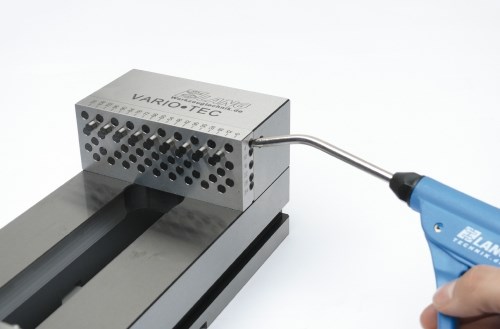Pins: The Alternative To Parallels
These vise jaws use protruding, mechanical pins to repeatedly support workpieces either horizontally or at angles. They are said to allow quicker setups than conventional parallels.
Share




Precision-ground parallels are commonly used to support workpieces that are too short to be supported by the base of the vise. They’re also used to lift workpieces above a vise’s base so that through holes can be drilled. Given the variety of work inherent to contract machining, shops often must keep a variety of parallel sizes on hand. And when setting up a job to create through holes, operators must be sure to use parallels appropriate for the operation so that the drill doesn’t contact and damage one of them as it pierces through the workpiece.
Lang Technovation, with U.S. headquarters in Waukesha, Wisconsin, has developed vise jaws that can eliminate the need for parallels. Its Vario Tec jaws have five rows of mechanical pins that can be actuated to protrude 10 mm from the face of each jaw. The pins make it possible to repeatedly support workpieces either horizontally at one of five different levels in the vise or at a 45-degree angle. Various other angles, in five-degree increments, are achieved by using optional angle plates that attach to the jaws. The company says its customers typically achieve setup times that are 20 to 30 percent faster than when parallels or other similar devices are used.
The Vario Tec jaws replace a vise’s standard jaws. (These jaws are currently available for use with Kurt 6-inch vises, although the company is developing versions that can be used with other vise brands.) Operators can actuate entire rows of pins using a pistol that blasts compressed air into row-specific ports located on the side of the jaws (see photo above). Pins that are not needed or those that might interfere with a through-hole drilling operation can simply be pushed back into the jaw. A single pin left protruding in the row above the supporting pins can serve as a workpiece stop for quick, repeatable positioning.
The jaws can also be used to support workpieces at an inverted, 45-degree angle. Angle plates that locate on a row of pins are available to clamp workpieces at various other angles. A selection of standard plates is offered in 5-degree increments to a maximum angle of 45 degrees (a 90-degree angle plate is also standard). Custom angle plates are available in 1-degree increments. The company also offers a prism clamping device that can hold round material in diameters ranging from 5 to 55 mm. These plates locate on two jaw pins and are fixed to the pins using a set screw.
In terms of maintenance, the company recommends blowing out all the pins when the vise will not be used for an extended period of time and lubricating them with WD40 or a similar penetrant. This prevents the pins from sticking in the jaws. Chips and debris aren’t an issue because the pins fit very tightly in their bores, the company says.
Related Content
-
Workholding Fixtures Save Over 4,500 Hours of Labor Annually
All World Machinery Supply designs each fixture to minimize the number of operations, resulting in reduced handling and idle spindle time.
-
Shop Doubles Sales with High-Mix, Low-Volume Automation
Robots with adaptive grippers have opened entire shifts of capacity to high-mix, low-volume shop Précinov, doubling its sales.
-
Lean Approach to Automated Machine Tending Delivers Quicker Paths to Success
Almost any shop can automate at least some of its production, even in low-volume, high-mix applications. The key to getting started is finding the simplest solutions that fit your requirements. It helps to work with an automation partner that understands your needs.

























.jpg;maxWidth=300;quality=90)

